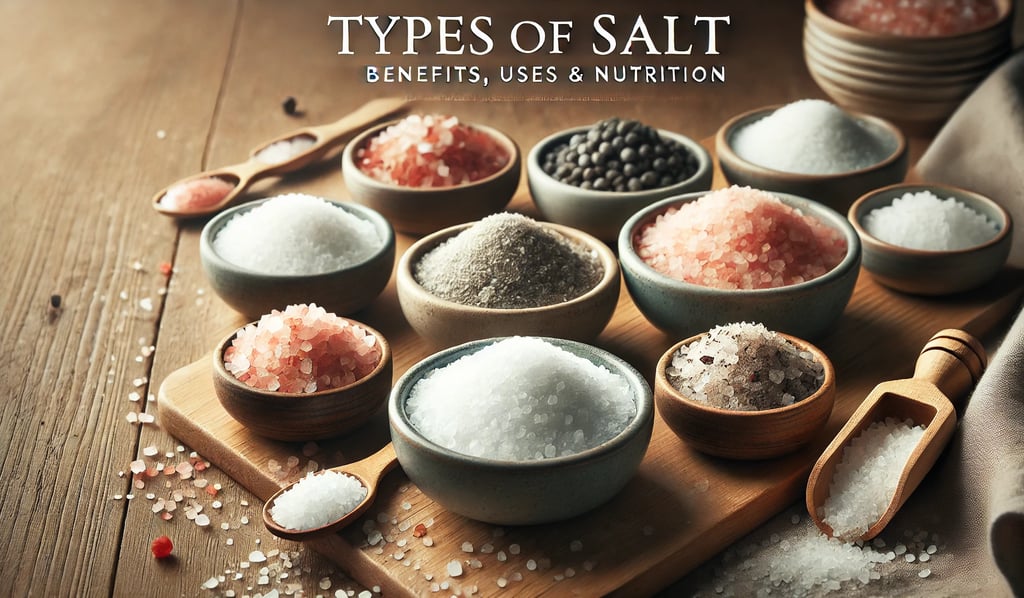Types of Salt: Benefits, Uses, and Nutritional Value
Introduction Salt is an essential mineral that plays a vital role in various bodily functions, including fluid balance, nerve signaling, and muscle contractions. However, not all salts are the same. This article explores different types of salt, their benefits, uses, and how to choose the best salt for your health. If you're searching for healthy salt options, Himalayan pink salt benefits, or the best Indian salt for cooking, this guide has you covered.
NUTRITION
3/20/20252 min read


1. Table Salt
Description:
Table salt is the most commonly used salt and is highly refined. It undergoes processing to remove impurities and contains added anti-caking agents to prevent clumping.
Nutritional Value:
Primarily sodium chloride (NaCl)
Often fortified with iodine to prevent iodine deficiency
May contain additives such as calcium silicate or dextrose
Best Uses:
Cooking and baking
Seasoning food
Pros:
Affordable and widely available
Contains iodine, essential for thyroid health
Cons:
Highly processed with additives
Lacks trace minerals
2. Sea Salt
Description:
Sea salt is obtained by evaporating seawater and is less processed than table salt, retaining trace minerals like magnesium, calcium, and potassium.
Nutritional Value:
Contains natural trace minerals
Less refined than table salt
Best Uses:
Enhancing flavors in cooking
Used in skincare and detox treatments
Pros:
Contains beneficial minerals
Less processed
Cons:
May contain microplastics due to ocean pollution
Lacks iodine unless fortified
3. Himalayan Pink Salt
Description:
Himalayan pink salt is mined from the Khewra Salt Mine in Pakistan and is rich in trace minerals, giving it its distinct pink color.
Nutritional Value:
Contains over 80 trace minerals, including iron, calcium, and magnesium
Slightly lower sodium content per teaspoon due to its larger crystals
Best Uses:
Finishing salt for meals
Used in bath soaks and salt lamps
Pros:
Rich in minerals
Popular for its health benefits
Cons:
More expensive than table salt
Minimal additional health benefits beyond regular salt
4. Celtic Sea Salt
Description:
Harvested from tidal pools off the coast of France, Celtic sea salt retains natural moisture and minerals.
Nutritional Value:
Rich in magnesium and potassium
Contains trace elements
Best Uses:
Ideal for seasoning seafood
Used in hydration and electrolyte drinks
Pros:
High mineral content
Supports hydration
Cons:
High moisture makes it difficult to use in some recipes
Expensive
5. Kosher Salt
Description:
Kosher salt has a coarser grain and is additive-free, making it a favorite among chefs.
Nutritional Value:
Pure sodium chloride, usually without iodine
Best Uses:
Seasoning meats and vegetables
Cooking and baking
Pros:
Free from additives
Provides better control over seasoning
Cons:
Lacks iodine
Dissolves slower than fine salt
6. Black Salt (Kala Namak) (Indian Salt)
Description:
Black salt, or kala namak, is a volcanic rock salt used in Indian cuisine. It has a strong sulfuric aroma.
Nutritional Value:
Contains sulfur compounds, iron, and other minerals
Best Uses:
Vegan dishes (egg substitute)
Ayurvedic and Indian cooking
Pros:
May aid digestion
Low sodium content
Cons:
Strong sulfuric smell
Limited culinary applications
7. Sendha Namak (Rock Salt) (Indian Salt)
Description:
Sendha namak, or Indian rock salt, is an unprocessed salt commonly used during fasting in India.
Nutritional Value:
Contains potassium, calcium, and magnesium
Less processed than table salt
Best Uses:
Ayurvedic medicine
Fasting foods
Pros:
Retains minerals
Beneficial for digestion
Cons:
Lacks iodine
Expensive compared to regular salt
8. Fleur de Sel
Description:
Fleur de Sel is a delicate hand-harvested salt from coastal France.
Nutritional Value:
Rich in trace minerals and moisture
Flaky texture
Best Uses:
Gourmet dishes
Enhancing chocolate and caramel desserts
Pros:
Delicate texture and flavor
Contains trace minerals
Cons:
Expensive
No significant health benefits over other salts
9. Hawaiian Black and Red Salt
Description:
Hawaiian black salt contains activated charcoal, while red salt (Alaea salt) is rich in volcanic clay.
Nutritional Value:
Black salt: Activated charcoal for digestion
Red salt: High iron content
Best Uses:
Grilling and garnishing
Hawaiian dishes
Pros:
Unique flavors and minerals
Cons:
Expensive
More of a culinary specialty
Final Thoughts: Which Salt is Best?
Choosing the best type of salt depends on your dietary needs and cooking preferences. If you're looking for a natural salt rich in minerals, Himalayan pink salt or Sendha namak are great options. For everyday use, iodized table salt ensures thyroid health. Sea salt and Celtic salt are excellent for those wanting less processed options. Kosher salt is perfect for controlled seasoning in cooking.
By incorporating these different salts into your diet, you can enjoy a variety of flavors while ensuring optimal nutrition. Whether you choose Himalayan pink salt, sea salt, or traditional Indian salts like kala namak and Sendha namak, understanding their benefits can help you make the best choice for your health and cooking needs.
Achieve fitness goals with personalized coaching today.
Contact US
Quick Links
sravankumarbalivada@gmail.com
+91 8121412668
© 2024. All rights reserved.
SRAVAN BALIVADA FITNESS
